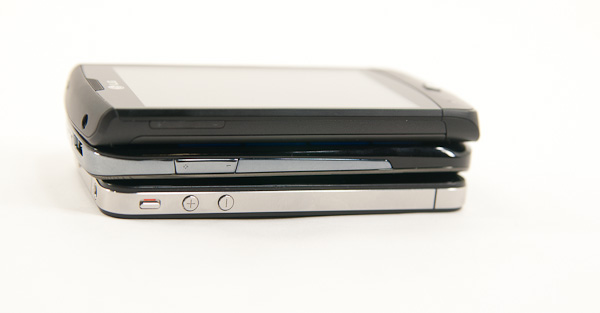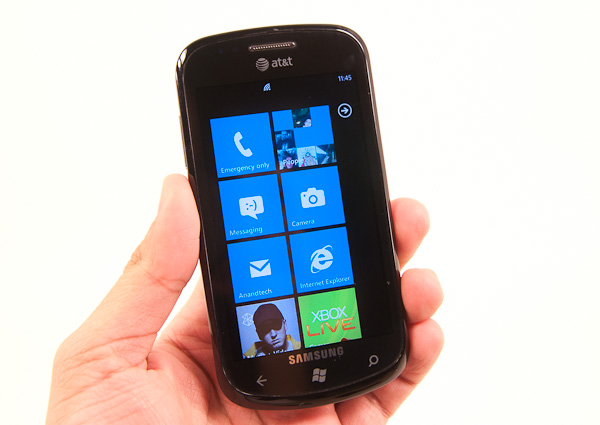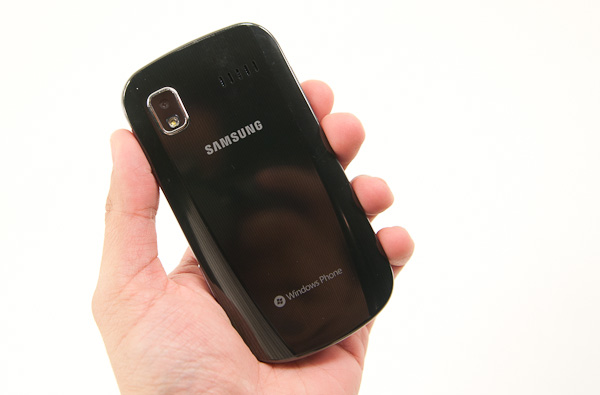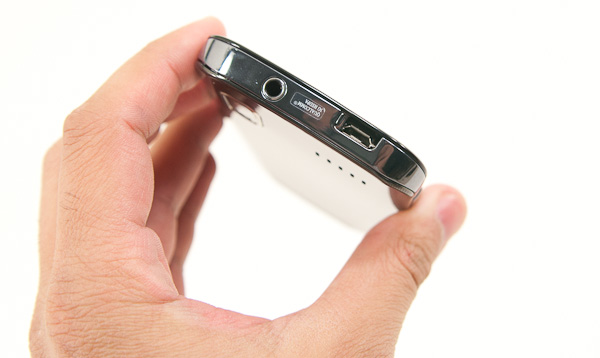LG's Optimus 7 & Samsung's Focus Reviewed: A Tale of Two Windows Phones
by Anand Lal Shimpi on December 3, 2010 10:14 PM EST- Posted in
- Smartphones
- Samsung
- Windows Phone 7
- LG Optimus
- LG
- Samsung Focus
- Mobile
The Samsung Focus
I spent more time with the Samsung Focus than any other Windows Phone prior to launch. It was the thinnest, it had the most eye catching screen and felt the most like a modern smartphone. It should, after all it’s lineage comes from the Galaxy S sans the Hummingbird SoC. Like the rest of the WP7 devices the Focus is based on Qualcomm’s first generation 65nm Snapdragon SoC.
The Focus is very thin but by virtue of its 4-inch Super AMOLED display has a larger surface area than the iPhone 4.

A cellular sandwich: LG Optimus 7, Samsung Focus, Apple iPhone 4 (from top to bottom)
Externally the Focus is made almost entirely of plastic with very carbon-fiberesque stripes on the back. The plastic construction makes the WP7 flagship very light, although some may find it too cheap feeling. The screen and the OS are what stand out about the Focus, not the physical construction of the phone itself.
Underneath the back cover you’ve got a microSD slot to expand beyond the integrated 8GB of NAND.
Along the top edge you’ve got a micro USB port with retractable cover, similar to what we’ve seen on the Epic 4G. This is much preferred to the cheap feeling dangling cover from the Optimus 7.
The three WP7 buttons are activated via capacitive touch. The buttons are clearly etched in the plastic and light up when touched. There’s a tasteful amount of haptic feedback when you tap them as well.
One issue that I’ve always had with the Focus is that it takes a ridiculous amount of time to fully charge. Over 7 hours. A quick Google search reveals that other Focus owners have had this problem, but not all. Microsoft indicated that the problem might appear with certain USB cables or wall charger combinations, but regardless of what I tried I had the problem. Buyer beware.













34 Comments
View All Comments
tonyfreak215 - Thursday, December 9, 2010 - link
You can pin a contact to the Main page. Just hold your finger on the contact and "Pin to start"EddyKilowatt - Monday, December 6, 2010 - link
During OLED's multi-year gestation, we saw lots of fetching display pics, though always with the text disclaimer "life of the organic emitters, however, remains a stumbling block".But now that products are on the shelves, the most penetrating journalism one can read about OLEDs amounts to, basically, "ohhhh... shiny!".
What is the backstory with OLED lifetime... was there a fundamental breakthrough that made it a non-problem, or was it merely increased "enough" that vendors think consumers will shrug and buy new toys when the old ones fade? Will today's eye-catching saturated colors look like old faded jeans at this time next year?
sviola - Monday, December 6, 2010 - link
Well, considering that people change cellphones in a 2-year schedule (usually when the plan is over), I don't think that the lifetime of the screen on a cellphone would matter much (2-year lifetime is around 17,5k hours if left on 24/7 - and I think Samsung AMOLED has a lifetime of 50k hours, which would translate to 5yr and 8mo of 24/7).xBabyJesus - Wednesday, December 8, 2010 - link
Anand, any chance you could do an update with read/write latency tests for a few flash cards? Apparently the sequential transfer speed (Class 2, 4, 6, etc) is pretty meaningless but the random read latency is make-or-break for Focus.